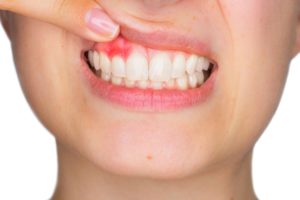 Unlike gum disease, which affects most areas of the mouth, pericoronitis causes gum inflammation in the area that surrounds the top of the tooth. It usually affects the third molars which are the teeth in the most rearward of the mouth or closest to the throat. In some cases, pericoronitis can occur chronically or acutely. Mild inflammation in the affected area is referred to as chronic. When symptoms progress to swelling, pain and fever, this is referred to as acute pericoronitis. At this stage, it usually signifies an infection that is starting to spread.
Unlike gum disease, which affects most areas of the mouth, pericoronitis causes gum inflammation in the area that surrounds the top of the tooth. It usually affects the third molars which are the teeth in the most rearward of the mouth or closest to the throat. In some cases, pericoronitis can occur chronically or acutely. Mild inflammation in the affected area is referred to as chronic. When symptoms progress to swelling, pain and fever, this is referred to as acute pericoronitis. At this stage, it usually signifies an infection that is starting to spread.
What causes it?
The bacterial build-up is the leading cause of pericoronitis. When the tooth has only erupted or pushed through the gums partially, there is usually unwanted or excess gum tissue that covers part of the tooth. This excess gum tissue that covers the top of the tooth usually covers it looselyBacteria and food debris gets trapped in the space between the tooth and the overlapping gum. This overlapping gum is called an “operculum.” Active infection is associated with an abscess that contains pus, which can spread if left unattended.
What are the risk factors?
Pericoronitis usually affects young adults whose teeth have not erupted into place properly. When the teeth do not fully erupt into place, the excess gum tissue that covers the partially unexposed part of the tooth is referred to as an operculum. Wisdom teeth that are difficult to clean are also prone to developing gum inflammation due to bacteria buildup and trapped food debris.
Signs and Symptoms
Symptoms can vary from mild to severe with accompanying fever, pain, swollen gums, tenderness, red gums, unpleasant breath, pus, difficulty swallowing, enlarged lymph nodes and reduced or loss of appetite.
Treatment
Treatment involves one or more steps. If an infection is present, medication may be prescribed to deal with the infection and pain. A minor surgical procedure may be done in the dental office to remove the excess gum tissue to prevent the issue from occurring again. The affected tooth may be removed or extracted if it does not serve any chewing function, due to its improper positioning or eruption height.
If you suffer from pericoronitis or believe you may be suffering from pericoronitis, contact us to schedule a complimentary consultation with one of our doctors.
About Dr. Joseph Salvaggio

Located in Brampton, Ontario Dr. Joseph Salvaggio has been practicing general, cosmetic, and implant dentistry for over 20 years. He enjoys interacting with his patients and helping to restore their oral health for better overall health as well. Meeting new patients, interacting and educating them is one of Dr. Salvaggio’s biggest joys. We encourage you to read our reviews or call us with any dental questions you have. We look forward to speaking with you and meeting you soon.
